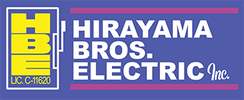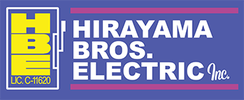|
Hirayama Brothers Electric embraces the traditional Hawaiian values of family and community support. We are proud of our Ohana!
Employees:
Family Members:
As hurricane season approaches, it's crucial for Hilo residents to prepare their homes to withstand potential storms. Ensuring your electrical system is ready can significantly reduce risks and ensure safety during severe weather. Here are some essential tips on how to prepare your home’s electrical system for the upcoming hurricane season, focusing on safety measures and essential upgrades.
1. Conduct a Professional Electrical Inspection The first step in preparing your home for hurricane season is to conduct a thorough electrical inspection. Hire a licensed electrician to examine your electrical system, including wiring, outlets, and the main electrical panel. A professional inspection can identify potential hazards, such as outdated wiring, overloaded circuits, or faulty connections, which could become dangerous during a storm. 2. Install Surge Protectors Power surges are common during hurricanes due to lightning strikes and downed power lines. These surges can damage your appliances and electronics, leading to costly repairs or replacements. Installing whole-house surge protectors can safeguard your electrical devices from sudden voltage spikes. Surge protectors are installed at your main electrical panel and can prevent excess voltage from reaching your outlets and appliances. 3. Upgrade to a Generator Power outages are a frequent occurrence during hurricanes. Investing in a generator can provide backup power to keep essential appliances and systems running during an outage. There are two main types of generators to consider:
Consult with an electrician to determine the best generator option for your home and ensure proper installation. 4. Elevate Electrical Components Flooding is a significant risk during hurricanes, especially in areas like Hilo. To protect your electrical system from water damage, consider elevating electrical components such as outlets, switches, and the main electrical panel. Installing these components at least one foot above the expected flood level can prevent water damage and reduce the risk of electrical fires. 5. Secure Outdoor Electrical Fixtures Outdoor electrical fixtures, such as lighting and outlets, are vulnerable during hurricanes. Ensure that all outdoor fixtures are securely mounted and sealed to prevent water infiltration. Use weatherproof covers for outdoor outlets and switch to outdoor-rated fixtures designed to withstand harsh weather conditions. 6. Prepare a Hurricane Safety Kit A well-prepared hurricane safety kit is essential for weathering the storm. Include essential electrical items such as flashlights, batteries, a battery-operated radio, and a portable phone charger. Additionally, keep a supply of extension cords and power strips to manage your electrical needs if you are using a generator. 7. Create an Emergency Electrical Plan Having an emergency electrical plan in place can help you respond quickly and safely during a hurricane. Your plan should include:
8. Regular Maintenance and Drills Regular maintenance of your electrical system is vital to ensure it remains in good condition. Schedule annual inspections and perform routine checks on your generator, surge protectors, and other critical components. Additionally, conduct drills with your family to practice your emergency electrical plan, ensuring everyone knows what to do in the event of a hurricane. Conclusion Preparing your home’s electrical system for hurricane season is a crucial step in protecting your property and ensuring the safety of your family. By conducting a professional inspection, installing surge protectors, upgrading to a generator, and following the other tips outlined above, you can minimize the risks associated with severe weather. Taking these proactive measures will help you weather the storm with confidence and peace of mind. For all your electrical needs and expert advice, contact Hirayama Brothers Electric. Our team of licensed electricians is here to help you prepare for hurricane season and ensure your home’s electrical system is safe and reliable.  April is an ideal month for Hilo residents to perform spring maintenance on their home’s electrical systems. Here’s a comprehensive guide to ensure your electrical setup is safe and efficient for the warmer months: 1. Inspect Electrical Outlets and Switches Check all outlets and switches for signs of wear or damage. Look for loose plugs, unusual sounds, or flickering lights, which could indicate wiring issues. Replace any damaged components to prevent potential hazards. 2. Test Ground Fault Circuit Interrupters (GFCIs) GFCIs are crucial for preventing electrical shock, especially in areas with moisture like kitchens and bathrooms. Test your GFCIs monthly by pressing the test button to ensure they trip properly, then reset them. 3. Clean and Organize Electrical Panels Remove any dust or debris from your electrical panels and ensure the area around them is clear. Label all breakers to make it easier to identify circuits during an emergency or power outage. 4. Check Extension Cords and Power Strips Inspect extension cords and power strips for any signs of fraying or damage. Avoid overloading them and only use cords rated for the power they will carry. 5. Update Light Bulbs to LEDs Replace incandescent bulbs with energy-efficient LED lights. LEDs use less energy, have a longer lifespan, and emit less heat, making them safer for enclosed fixtures and reducing cooling costs. 6. Examine Outdoor Electrical Components Spring is a good time to inspect outdoor lighting, outlets, and wiring. Ensure they are weatherproof and free from damage. Replace any fixtures that show signs of wear to avoid potential electrical hazards. 7. Schedule a Professional Electrical Inspection Consider hiring a licensed electrician to perform a comprehensive inspection of your home’s electrical system. They can identify and address any hidden issues, ensuring your system is safe and up to code. 8. Install or Test Smoke and Carbon Monoxide Detectors Ensure your home is equipped with working smoke and carbon monoxide detectors. Test them monthly, replace batteries as needed, and consider upgrading to interconnected systems for enhanced safety. Conclusion Spring maintenance is essential for keeping your home’s electrical system safe and efficient. By performing these checks and updates, you can prevent potential hazards and ensure your home is ready for the warmer months ahead. For expert assistance and comprehensive electrical services, contact Hirayama Brothers Electric. Our team of licensed electricians is here to help you with all your electrical needs. |
About our Ohana
All
|



 RSS Feed
RSS Feed


